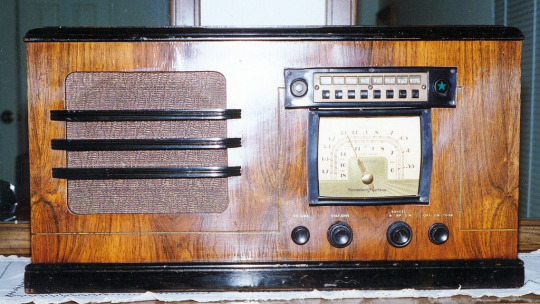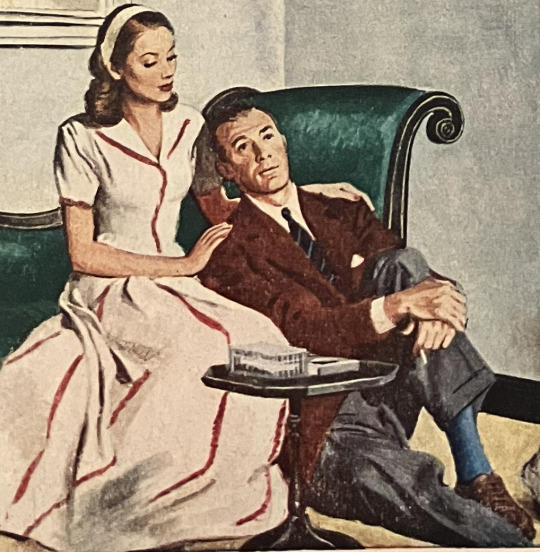Special Collections in Mass Media & Culture, formerly and still informally known as the "Broadcasting Archives," is located in Hornbake Library on the campus of the University of Maryland in College Park. Our signature collections are the Library of American Broadcasting (LAB) and the National Public Broadcasting Archives (NPBA). These include a wide-ranging collection of audio and video recordings, books, pamphlets, periodicals, personal collections, oral histories, photographs, and scripts devoted to the history of broadcasting, journalism, mass media and culture. Phone: (301) 405-9212 Email: [email protected] Twitter: @Bcast_Md
Don't wanna be here? Send us removal request.
Photo
Originally posted June 20, 2015. | Tumblr Archive

16 notes
·
View notes
Photo
Originally posted June 20, 2015. | Tumblr Archive

Here are earlier entries featuring Detroit’s WJR-AM.
19 notes
·
View notes
Photo
Originally posted June 20, 2015. | Tumblr Archive


Bravour Safir (Denmark, 1944-45)
Tubes: UCH21 UCH21 UBL21 UY1
Source: radiomuseum-croatia.com
39 notes
·
View notes
Text

#QSLfriday WHBC is the oldest radio station in Canton, Ohio. It began broadcasting on March 9, 1925. Father Edward P. Graham of St. John Catholic Church was the original owner. In 1936, the Brush-Moore Newspapers, then owners of Canton's daily newspaper, The Repository, purchased the station. A business group named the Ohio Broadcasting Company bought it in 1939. The station was not a part of any network until 1940 or 1941, when it became a Mutual Broadcasting System network affiliate. It became an ABC affiliate later in the 1940s.
4 notes
·
View notes
Text

#GameShowWednesday (one in a series from our archive)
Winston Conrad "Wink" Martindale (1933–2025) was a disc jockey, radio personality, game show host, and television producer. He was well-known for hosting the game show Tic-Tac-Dough from 1978 to 1985, but his first game show was What's This Song? (above), which he hosted for NBC (credited as "Win Martindale") from 1964 to 1965.
Source: Library of American Broadcasting photo archive. (Photo has been colorized.)
1 note
·
View note
Photo
Originally posted June 17, 2015. | Tumblr Archive

Vintage Watterson Model 57 Radio, Broadcast & Short Wave Bands, Wood Cabinet, Made In USA. Image by France1978.
21 notes
·
View notes
Photo
Originally posted June 17, 2015. | Tumblr Archive

Vintage Magazine - Family Circle (Sept 1953).
85 notes
·
View notes
Photo
Originally posted June 17, 2015. | Tumblr Archive

Vintage Stromberg Carlson Push Button Radio with Tuning Eye, Circa 1930s. Image by France1978.
16 notes
·
View notes
Photo
Originally posted June 16, 2015. | Tumblr Archive

Collections often overlap. This pink TV from Sharp (1986, Japan) appeals both as pure design and as vintage technology. Photo from the book “Vintage Transistor Televisions” by Eric Wrobbel.
142 notes
·
View notes
Photo
(Click to enlarge)
Originally posted June 16, 2015. | Tumblr Archive

The Radio (Board) Game, by Milton Bradley. Mid-1920s.
32 notes
·
View notes
Photo
Originally posted June 16, 2015. | Tumblr Archive

Radialva Super-Groom (by kitchener.lord on Flickr).
21 notes
·
View notes
Text

"These programs served as more than simple entertainment, though entertaining they often were; the problem was that even the television industry didn't take them seriously enough. My efforts to track down some of these programs were ample proof that when it came to preserving its own history, television took itself no more seriously than many of its critics did." [More here.]
3 notes
·
View notes
Text

#QSLfriday WHO began broadcasting on April 10, 1924. The station was initially owned by Bankers Life. Because its call letters were issued outside of the pattern commonly employed at the time, there has been speculation that they might have been chosen to stand for "We Help Others" or the question "Who?" WHO has used an owl as its mascot, a play on its call letters, pronounced like an owl's call, for many years.
In late 1929, the Central Broadcasting Company purchased WHO. Through its early years, WHO was a network affiliate of the NBC Red Network, broadcasting comedies, dramas, game shows, soap operas, sports, and big bands.
5 notes
·
View notes
Photo
Originally posted June 12, 2015. | Tumblr Archive

Here are earlier entries about Jackson’s WLBT-TV.
19 notes
·
View notes
Text

#GameShowWednesday (one in a series from our archive)
Some consider the 1970s the "golden age" of game shows. That was certainly true in terms of their sheer numbers. By the mid-1970s, game shows were booming, with over twenty-five different shows airing on both the networks and in syndication on local stations.
These gentlemen were frequent hosts during those years. In 1974, you could find (top row) Jim Lange on "The Dating Game" and Allen Ludden on "Password," (center row) Wink Martindale on "Gambit" and Bob Eubanks on "The Newlywed Game," (bottom row) Garry Moore on "To Tell the Truth," and Tom Kennedy on "Split Second."
Not everyone was pleased with the trend. In 1974, a New York Times reporter complained that on weekdays, on a single channel between 9:30 am and 2 pm, one could watch "no fewer than nine straight game shows."
"That's not a trend," he added, "that's a glut."
Source: Library of American Broadcasting photo archive.
3 notes
·
View notes
Photo
Small Portable Wood and Leatherette Roberts Rambler Radio, early 1970s.
Originally posted June 11, 2015. | Tumblr Archive

28 notes
·
View notes
Text


"And after the war, when television develops, watch RCA again! Once more you'll agree, RCA leads the way in Radio, Television and Electronics." (1944)
108 notes
·
View notes